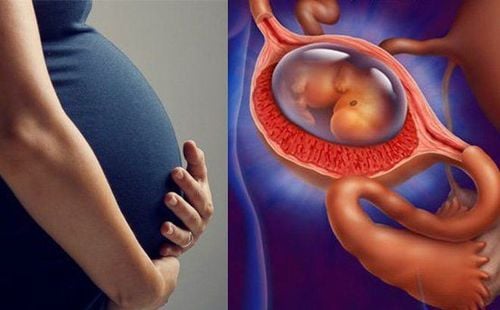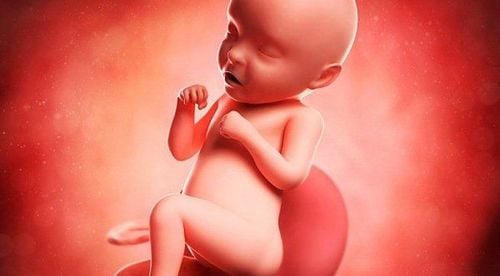This is an automatically translated article.
The article was professionally consulted by Dr. Nguyen Anh Tu - Doctor of Obstetric Ultrasound - Prenatal Diagnosis - Obstetrics Department - Vinmec Hai Phong International General Hospital.The brain development of the fetus from the womb is an extremely miraculous process. Right from the 3rd week of pregnancy, the baby's brain has begun to form, develop and continuously improve until the fetus is born.
1. Structure in the fetal brain
In terms of anatomical structure, the human brain is divided into 5 different regions, each of which is responsible for a separate function, including:
Cerebrum: This is the largest part of the brain, responsible for thinking, remembering, and feeling. The cerebrum is also home to the cerebral cortex and lobes, including the frontal and temporal lobes. Cerebellum: This area coordinates movement, maintains posture, and creates a sense of balance. Brainstem: The center that controls many of the most important functions, including heart rate, breathing, and blood pressure. Pituitary gland: About the size of a pea, in charge of releasing hormones into the body, supporting growth, metabolism and performing a number of other functions. Hypothalamus: Area involved in body temperature, feelings of hunger and thirst, sleep, and emotions.
2. First trimester: Baby starts to move
After only 16 days of conception, the neural foundation of the fetus begins to form, grows in length and has folds. They then turn into a groove that gradually forms a neural tube.
Around 6-7 weeks of pregnancy, the neural tube closes in a curvilinear fashion and divides into three parts, including: vestibule, midbrain, and posterior brain. The spinal cord will soon appear in the area adjacent to the posterior brain. Not long after, fetal brain development also originates from the neural tube and divides into the 5 regions as listed in section 1. However, all areas of the fetal brain still need more more time to continue to mature fully.
Also during this stage, a number of special neurons are present and migrate throughout the embryo to give rise to the first nerves. Your baby's nervous system is made up of millions upon millions of nerve cells; In each of these microcells there are branches so that they connect and transmit information to each other. Essentially, the first synapses also form and produce early fetal movements, such as curling into place.
Some other movements also take place quickly, the fetus can wiggle its limbs and start to develop touch by the 8th week. By the end of the first trimester, the baby is already able to do quite a lot. act even though she still can't feel it.
3. Second trimester: The reflexes
During the second trimester, the fetal brain controls the regular contractions of the diaphragm and chest muscles, similar to breathing. At the same time, a protective layer that speeds up the transmission of signals between nerve cells, called myelin, will appear and cover the baby's nerves. Myelin will continue to grow until a child is one year old.
16 weeks: Baby first learns to suck and swallow. Around week 18: You begin to notice your baby's first kick. However, the first kick can also come a few weeks later, especially in first-time mothers. Week 21: A natural reflex causes your baby to swallow several dozen mL of amniotic fluid a day. This action will help the taste buds gradually develop more complete. Week 24: Another remarkable reflex occurs, that is, the baby knows how to wink. Week 27: When the second trimester ends, your baby's nervous system is still maturing. By the end of the second trimester, the fetal brain stem is almost completely mature. They are located just above the spinal cord and below the cerebral cortex - the final maturation area. At this time, the fetal nervous system has developed enough for the baby to startle if there are loud noises outside the uterus, or even to turn its head in the direction of the voice of a loved one. If you want to use music to stimulate the baby's brain, this is the right time.

4. Third trimester: Brain development
At 28 weeks of pregnancy, the central nervous system can control rhythmic breathing and control body temperature. In particular, the baby's brain wave activity appeared in the sleep cycle, including the dream phase. When is the fetal brain most developed? The third trimester is the period when cells and the nervous system develop the most rapidly, specifically:
4.1 Mass Fetal brain development triples in weight during the last 13 weeks of pregnancy. period, from about 100g at the end of the second trimester to almost 300g at this point.
4.2 Surface The surface of the brain also looks different, no longer as smooth as it used to be, but more and more grooves and wrinkles, similar to the usual image of the brain.
4.3 Cerebellum The cerebellum, which controls movement, is the fastest-growing region in the entire fetal brain, with its surface area increasing 30-fold in just the last 16 weeks of pregnancy.
4.4 Cortices Although this most important area of the brain is still developing rapidly during pregnancy, the cortex only really begins to function around the time the baby is nearing birth. The cerebral cortex will continue to mature during the first few years of a baby's life thanks to the variety of environments in the outside world.
5. Good diet for fetal brain development

5.1 Folic acid/vitamin B Because the baby's nervous system begins to develop at the moment of conception, women should take 400 micrograms of folic acid, also known as vitamin B, every day from the moment of conception. want to get pregnant.
This nutrient is essential for fetal cell, tissue and DNA development. Research shows that early supplementation of this substance before pregnancy will help reduce the risk of serious neural tube defects by 70% and the rate of children being born with autism spectrum disorder by 40%. That's why, take your prenatal vitamin B (at least 400 mcg) and make sure to eat plenty of foods rich in folic acid, including green vegetables and whole grains.
5.2 Omega fatty acids Specifically DHA , aka docosahexaenoic acid , is also important for fetal brain and eye development . Because it is the main structural fat in the baby's brain and eyes, it is essential to get enough omega-3 fatty acids, especially at the period of fetal brain development is most active. third trimester). DHA is found in many fatty and cold water fish such as salmon and cod. In addition, consuming seaweed along with eggs also adds a dose of DHA to the body.
Vinmec International General Hospital offers a Package Maternity Care Program for pregnant women right from the first months of pregnancy with a full range of antenatal care visits, periodical 3D and 4D ultrasounds and routine tests to ensure that the mother is healthy and the fetus is developing comprehensively. In addition to regular check-ups, pregnant women will also be advised on nutrition and exercise so that the mother can gain weight reasonably while the fetus still absorbs nutrients well.
Doctor Nguyen Anh Tu has 6 years of experience in obstetrics and gynecology ultrasound, specially researched and trained in pregnancy ultrasound - prenatal diagnosis. Dr. Tu has completed courses on ultrasound - prenatal diagnosis of the FMF International Fetal Medicine Association; trained in consulting and implementing diagnostic intervention techniques in fetal medicine and participated in many specialized conferences and seminars on Fetal Medicine. Currently, he is a doctor at the Department of Obstetrics and Gynecology, Vinmec Hai Phong International General Hospital.
Please dial HOTLINE for more information or register for an appointment HERE. Download MyVinmec app to make appointments faster and to manage your bookings easily.
Article reference source: Whattoexpect.com; Ncbi.nlm.gov; Mayoclinic.org













